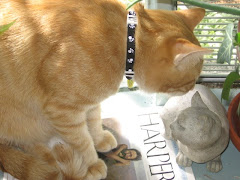
The Stinking Rose
Text and Photos by : Füsun Atalay ~ Copyright © 2006
In 1861, Isabelle Mary Beeton became the most famous cookery writer in the British history when she published "Mrs Beeton's Book of Household Management," in which she wrote "... the smell of this plant is generally considered offensive, and it is the most acrimonious in taste."
Much has changed since her time, and a lot for the better - especially in the fascinating world of cooking, even though it may have taken a while for the English speaking world to embrace garlic, the "offensive," stinking rose.
Today, garlic is used around the world in many ways - raw, cooked, crushed, sliced or whole. It tastes stronger raw than it does when it's cooked.
Minced garlic is stronger in taste than sliced garlic, just as roasted whole garlic has a completely different taste from crushed raw garlic.
Cooking or roasting whole garlic gives it a milder, almost a sweet taste so unlike its raw, finely chopped counterpart reserved for the real aficionados.
It should go without saying that the longer garlic cooks the more mellower it will taste - as along as the cloves are left whole.Roast an entire bulb of garlic for about 20-25 minutes in a 350° F oven. Cut about 1 inch off the top and squeeze out the pulp inside. Mash it to a purée and spread it on toasted bread or flavour your favourite recipes. Simply delicious!
But first, it's important to know the difference between a bulb (sometimes called head) and a clove.
Garlic is a plant of the genus allium and it grows under the ground in large bulbs, covered by an off-white, papery skin. Anywhere from 10 to 20 individual cloves with a pinkish skin can be found inside each bulb.
Leeks, onions and shallots are garlic's well-known cousins in the Alliaceae family. Cultivated garlic (allium sativum) is what is most commonly sold in the supermarkets.
Occasionally, one may see the elephant garlic which may look attractive because of its huge cloves, but as far as taste goes it is very mild and a poor substitute for "The Real McClove."When buying garlic, seek firm bulbs with plenty of papery layers. If green shoots are visible, don't buy it. A garlic bulb that's past its prime will crumble when you squeeze it slightly between your fingers.
Store garlic bulbs in a cool and dry place away from direct light. Specially designed earthenware garlic keepers with air holes are ideal for storage because they allow the bulbs to breathe as the air circulates. Refrigerator or a plastic bag is not a friendly environment for garlic because it will cause mould.
A chopping board, a chef's knife and some coarse salt are the best tools for chopping garlic. Sprinkle coarse salt on the chopping board, place the garlic clove on it and give it a good "whack" with the flat part of the blade. Then proceed to chop the smashed clove as finely as you desire.The salt absorbs the exuding juices as well as providing a stable bed for the chopping. However, if you're finicky about having garlic odour on your hands, use a garlic crusher.
Aside from its culinary popularity, this "stinking rose" has also has enjoyed an unparalleled reputation in mythology and folk medicine for its health giving properties. In the 19th century Louis Pasteur discovered - under laboratory conditions - that bacterial cells ceased to exist when they were saturated with garlic.
Albert Schweitzer used garlic in treating typhus and cholera, while British doctors relied on its antibacterial powers in treating the wounded during a battle in the Second World War.
A number of modern studies confirm that garlic is definitely effective against many bacteria, fungi and viruses and should be considered as an aid in fighting certain infections.
Next time you want to reach for a natural and powerful antibiotic, crush some raw garlic and add it to your cooked soup or stew shortly before serving it.
Worried about unpleasant smelling breath afterwards? Chewing raw parsley is a commonly recommended panacea to alleviate this condition.
Pilâki Serves 4
This family recipe with Romano beans, carrots, potatoes and garlic in an olive-oil tomato sauce is a delicious vegetarian meal that is eaten at room temperature.
1/4 cup olive oil
1 small onion, chopped
10-12 garlic cloves, peeled, left whole
1/3 cup diced tomatoes
1 large potato, cubed
2 stalks celery, sliced
2 carrots, sliced
1/2 cup water
1 -28 oz can Romano beans, drained
salt and black pepper to taste
1/4 cup chopped parsley
lemon slices, for garnish
In a saucepan heat oil and saute onions. Add garlic cloves and diced tomatoes, cook for a minute. Stir in potatoes, carrots and celery; season with salt and pepper, add water, cover and simmer over medium heat until vegetables are tender but firm (about 10 minutes). Add Romano beans, stir to mix and cook for another 10 minutes. Transfer to a serving dish, sprinkle with chopped parsley and garnish with lemon slices. Serve at room temperature with extra squeeze of lemon juice.
Slow Cooked Chicken with 40 Cloves of Garlic Serves 6
3 sprigs fresh thyme
2 sprigs fresh rosemary
2 sprigs fresh sage
4 springs fresh Italian (flat) parsley
40 cloves garlic, unpeeled
1 Tsp kosher salt
1/2 tsp ground black pepper
2 kg whole chicken
3 stalks celery, cut in half
French bread,sliced and toasted
Place 1 sprig thyme, rosemary, sage and parsley in chicken cavity. Place celery on stoneware in a criss cross pattern. Rest chicken on top of celery. Add garlic cloves around chicken. Chop and sprinkle remaining herbs, salt and pepper over chicken.Cover cook on Low setting 8-10 hours or on High setting 4-6 hours. Do not open the cover during cooking.To serve, place chicken, garlic and celery on serving plate. Squeeze roasted garlic out of skins onto toasted bread slices and spread with a knife.







































